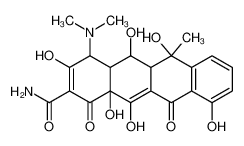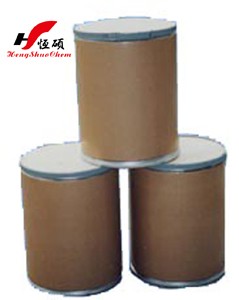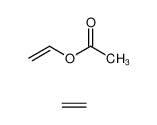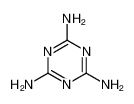| Product name | oxytetracycline |
|---|
| Product number | - |
|---|---|
| Other names | adamycin |
| Identified uses | For industry use only. Veterinary Drug: ANTIMICROBIAL_AGENT |
|---|---|
| Uses advised against | no data available |
| Company | MOLBASE (Shanghai) Biotechnology Co., Ltd. |
|---|---|
| Address | Floor 4 & 5, Building 12, No. 1001 North Qinzhou Road, Xuhui District, Shanghai, China |
| Telephone | +86(21)64956998 |
| Fax | +86(21)54365166 |
| Emergency phone number | +86-400-6021-666 |
|---|---|
| Service hours | Monday to Friday, 9am-5pm (Standard time zone: UTC/GMT +8 hours). |
Acute toxicity - Oral, Category 4
Acute toxicity - Dermal, Category 4
Acute toxicity - Inhalation, Category 4
2.2 GHS label elements, including precautionary statements| Pictogram(s) | 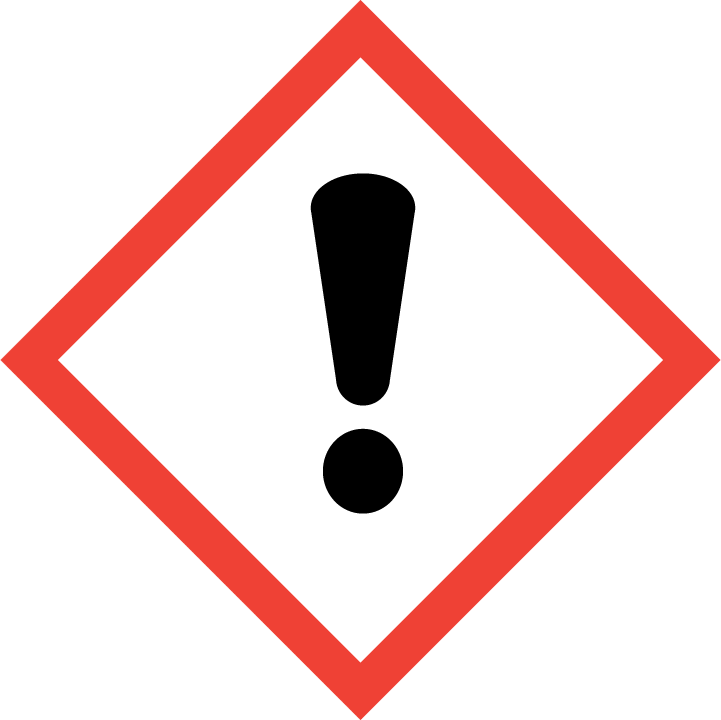 |
|---|---|
| Signal word | Warning |
| Hazard statement(s) | H302 Harmful if swallowed H312 Harmful in contact with skin H332 Harmful if inhaled |
| Precautionary statement(s) | |
| Prevention | P264 Wash ... thoroughly after handling. P270 Do not eat, drink or smoke when using this product. P280 Wear protective gloves/protective clothing/eye protection/face protection. P261 Avoid breathing dust/fume/gas/mist/vapours/spray. P271 Use only outdoors or in a well-ventilated area. |
| Response | P301+P312 IF SWALLOWED: Call a POISON CENTER/doctor/…if you feel unwell. P330 Rinse mouth. P302+P352 IF ON SKIN: Wash with plenty of water/... P312 Call a POISON CENTER/doctor/…if you feel unwell. P321 Specific treatment (see ... on this label). P362+P364 Take off contaminated clothing and wash it before reuse. P304+P340 IF INHALED: Remove person to fresh air and keep comfortable for breathing. |
| Storage | none |
| Disposal | P501 Dispose of contents/container to ... |
none
3.Composition/information on ingredients 3.1 Substances| Chemical name | Common names and synonyms | CAS number | EC number | Concentration |
|---|---|---|---|---|
| oxytetracycline | oxytetracycline | 79-57-2 | none | 100% |
Consult a physician. Show this safety data sheet to the doctor in attendance.
If inhaledIf breathed in, move person into fresh air. If not breathing, give artificial respiration. Consult a physician.
In case of skin contactWash off with soap and plenty of water. Consult a physician.
In case of eye contactRinse thoroughly with plenty of water for at least 15 minutes and consult a physician.
If swallowedNever give anything by mouth to an unconscious person. Rinse mouth with water. Consult a physician.
4.2 Most important symptoms/effects, acute and delayedSYMPTOMS: Symptoms of exposure to this compound may include nausea, anorexia, vomiting, diarrhea, glossitis, dysphagia, enterocolitis, inflammatory lesions (with monilial overgrowth) in the anogenital region; edema, benign intracranial hypertension, anaphylaxis, anaphylactoid purpura, pericarditis, exacerbation of systemic lupus erythematosus, hemolytic anemia, neutropenia, thrombocytopenia and eosinophilia. It can cause hypersensitivity reactions, such as rashes, urticaria, dermatitis, atrophic or hypertrophic glossitis, burning of the eyes, cheilosis, pruritus ani or vulvae, vaginitis and fever. Other symptoms of exposure to this type of compound include gastrointestinal disturbances with flatulence, drug fever, rise in blood urea and clinical deterioration in those with renal impairment. This class of compounds may also cause an overgrowth of resistant organisms (such as Candida species and other fungi) in the mouth and intestines, producing angular stomatitis, and rectal and vaginal irritation. It may also cause marked changes in the intestinal flora, resulting in multiplication of resistant organisms and deficiency of B vitamins. Staphylococcal enterocolitis may occur suddenly, often ending fatally. It may cause liver damage, especially in pregnancy. ACUTE/CHRONIC HAZARDS: When heated to decomposition this compound emits very toxic fumes of hydrogen chloride and nitrogen oxides.
4.3 Indication of immediate medical attention and special treatment needed, if necessary/SRP:/ Basic treatment: Establish a patent airway (oropharyngeal or nasopharyngeal airway, if needed). Suction if necessary. Watch for signs of respiratory insufficiency and assist ventilations if needed. Administer oxygen by nonrebreather mask at 10 to 15 L/min. Monitor for pulmonary edema and treat if necessary ... . Monitor for shock and treat if necessary ... . Anticipate seizures and treat if necessary ... . For eye contamination, flush eyes immediately with water. Irrigate each eye continuously with 0.9% saline (NS) during transport ... . Do not use emetics. For ingestion, rinse mouth and administer 5 ml/kg up to 200 ml of water for dilution if the patient can swallow, has a strong gag reflex, and does not drool ... . Cover skin burns with dry sterile dressings after decontamination ... . /Poisons A and B/
5.Fire-fighting measures 5.1 Extinguishing media Suitable extinguishing mediaFires involving this material can be controlled with a dry chemical, carbon dioxide or Halon extinguisher.
5.2 Specific hazards arising from the chemicalFlash point data for this chemical are not available. It is probably combustible.
5.3 Special protective actions for fire-fightersWear self-contained breathing apparatus for firefighting if necessary.
6.Accidental release measures 6.1 Personal precautions, protective equipment and emergency proceduresUse personal protective equipment. Avoid dust formation. Avoid breathing vapours, mist or gas. Ensure adequate ventilation. Evacuate personnel to safe areas. Avoid breathing dust. For personal protection see section 8.
6.2 Environmental precautionsPrevent further leakage or spillage if safe to do so. Do not let product enter drains. Discharge into the environment must be avoided.
6.3 Methods and materials for containment and cleaning upPick up and arrange disposal. Sweep up and shovel. Keep in suitable, closed containers for disposal.
7.Handling and storage 7.1 Precautions for safe handlingAvoid contact with skin and eyes. Avoid formation of dust and aerosols. Avoid exposure - obtain special instructions before use.Provide appropriate exhaust ventilation at places where dust is formed. For precautions see section 2.2.
7.2 Conditions for safe storage, including any incompatibilitiesOxytetracycline hydrochloride preparations should be stored at a temperature less that 40°C, preferably between 15-30°C; freezing of oxytetracycline injection should be avoided. Oxytetracycline hydrochloride capsules should be stored in tight, light-resistant containers. /Oxytetracycline hydrochloride/
8.Exposure controls/personal protection 8.1 Control parameters Occupational Exposure limit valuesno data available
Biological limit valuesno data available
8.2 Appropriate engineering controlsHandle in accordance with good industrial hygiene and safety practice. Wash hands before breaks and at the end of workday.
8.3 Individual protection measures, such as personal protective equipment (PPE) Eye/face protectionSafety glasses with side-shields conforming to EN166. Use equipment for eye protection tested and approved under appropriate government standards such as NIOSH (US) or EN 166(EU).
Skin protectionWear impervious clothing. The type of protective equipment must be selected according to the concentration and amount of the dangerous substance at the specific workplace. Handle with gloves. Gloves must be inspected prior to use. Use proper glove removal technique(without touching glove's outer surface) to avoid skin contact with this product. Dispose of contaminated gloves after use in accordance with applicable laws and good laboratory practices. Wash and dry hands. The selected protective gloves have to satisfy the specifications of EU Directive 89/686/EEC and the standard EN 374 derived from it.
Respiratory protectionWear dust mask when handling large quantities.
Thermal hazardsno data available
9.Physical and chemical properties| Physical state | Pale yellow to tan, crystalline powder. |
|---|---|
| Colour | Light-yellow crystals or needles from aqueous MeOH |
| Odour | no data available |
| Melting point/ freezing point | 183ºC |
| Boiling point or initial boiling point and boiling range | 817.08ºC at 760 mmHg |
| Flammability | no data available |
| Lower and upper explosion limit / flammability limit | no data available |
| Flash point | 447.954ºC |
| Auto-ignition temperature | no data available |
| Decomposition temperature | no data available |
| pH | no data available |
| Kinematic viscosity | no data available |
| Solubility | In water:0.2 g/L |
| Partition coefficient n-octanol/water (log value) | no data available |
| Vapour pressure | 9.7X10-25 mm Hg at 25°C (est) |
| Density and/or relative density | 1.634 g/cm3 (20ºC) |
| Relative vapour density | no data available |
| Particle characteristics | no data available |
no data available
10.2 Chemical stabilitySTABLE IN AIR, BUT EXPOSURE TO STRONG SUNLIGHT CAUSES IT TO DARKEN. /OXYTETRACYCLINE DIHYDRATE/
10.3 Possibility of hazardous reactionsOXYTETRACYCLINE HYDROCHLORIDE is sensitive to light. It may be unstable at temperatures above 25°C. It darkens on exposure to sunlight or to moist air above 90°C. Concentrated aqueous solutions at neutral pH hydrolyze on standing. This chemical undergoes hydrolysis in the presence of water. It may be incompatible with alkalis.
10.4 Conditions to avoidno data available
10.5 Incompatible materialsno data available
10.6 Hazardous decomposition productsno data available
11.Toxicological information Acute toxicity- Oral: LD50 Swiss mice oral 7200 mg/kg /hydroxytetracycline monohydrochloride/
- Inhalation: no data available
- Dermal: no data available
no data available
Serious eye damage/irritationno data available
Respiratory or skin sensitizationno data available
Germ cell mutagenicityno data available
Carcinogenicityno data available
Reproductive toxicityno data available
STOT-single exposureno data available
STOT-repeated exposureno data available
Aspiration hazardno data available
12.Ecological information 12.1 Toxicity- Toxicity to fish: LC50 Lepomis macrochirus (Bluegill) >100 ppm/96 hr; static /formulated product/[USEPA, Office of Pesticide Programs; Pesticide Ecotoxicity Database (2000) on
- Toxicity to daphnia and other aquatic invertebrates: EC50 Daphnia magna (Water flea; intoxication, immobilization) >102 ppm/48 hr; static /formulated product/[USEPA, Office of Pesticide Programs; Pesticide Ecotoxicity Database (2000) on
- Toxicity to algae: no data available
- Toxicity to microorganisms: no data available
AEROBIC: Oxytetracycline in a soil and manure sample underwent 0% degradation after 180 days(1). Fifty percent degradation of oxytetracycline took place in an aerobic sediment slurry after 43.8 days(1). Oxytetracycline in soil was degraded to 17 and 39% of the initial concentrations of 60 and 600 mg, respectively, after 35 days and to 3 and 29% of the initial concentrations of 120 and 1200 mg/kg, respectively, after 100 days during manometric respirometry tests(2).
12.3 Bioaccumulative potentialAn estimated BCF of 0.12 was calculated for oxytetracycline(SRC), using a log Kow of -0.90(1) and a regression-derived equation(2). According to a classification scheme(3), this BCF suggests the potential for bioconcentration in aquatic organisms is low(SRC).
12.4 Mobility in soilKoc values measured for oxytetracycline were 42,506 in Askov sandy loam soil (1.6% organic carbon), 93,317 in Flakkebjerg sandy loam soil (1.1% organic carbon), 27,792 in Borris loamy sand (1.5% organic carbon), and 47,881 in Lundgaard sandy soil (1.4% organic carbon)(1,2,3,4). The Koc of oxytetracycline measured in manure (49% organic carbon) was 195(4,5). According to a classification scheme(6), this range of Koc values suggests that oxytetracycline is expected to have moderate to no mobility in soil. Based on a measured pKa value of 9.5 (tertiary amine)(5), oxytetracycline is expected to exist primarily as a cation in the environment and cations generally have lower mobility in soil than their neutral counterparts(7).
12.5 Other adverse effectsno data available
13.Disposal considerations 13.1 Disposal methods ProductThe material can be disposed of by removal to a licensed chemical destruction plant or by controlled incineration with flue gas scrubbing. Do not contaminate water, foodstuffs, feed or seed by storage or disposal. Do not discharge to sewer systems.
Contaminated packagingContainers can be triply rinsed (or equivalent) and offered for recycling or reconditioning. Alternatively, the packaging can be punctured to make it unusable for other purposes and then be disposed of in a sanitary landfill. Controlled incineration with flue gas scrubbing is possible for combustible packaging materials.
14.Transport information 14.1 UN Number| ADR/RID: no data available | IMDG: no data available | IATA: no data available |
| ADR/RID: no data available |
| IMDG: no data available |
| IATA: no data available |
| ADR/RID: no data available | IMDG: no data available | IATA: no data available |
| ADR/RID: no data available | IMDG: no data available | IATA: no data available |
| ADR/RID: no | IMDG: no | IATA: no |
no data available
14.7 Transport in bulk according to Annex II of MARPOL 73/78 and the IBC Codeno data available
15.Regulatory information 15.1 Safety, health and environmental regulations specific for the product in question| Chemical name | Common names and synonyms | CAS number | EC number |
|---|---|---|---|
| oxytetracycline | oxytetracycline | 79-57-2 | none |
| European Inventory of Existing Commercial Chemical Substances (EINECS) | Listed. | ||
| EC Inventory | Listed. | ||
| United States Toxic Substances Control Act (TSCA) Inventory | Listed. | ||
| China Catalog of Hazardous chemicals 2015 | Not Listed. | ||
| New Zealand Inventory of Chemicals (NZIoC) | Listed. | ||
| Philippines Inventory of Chemicals and Chemical Substances (PICCS) | Listed. | ||
| Vietnam National Chemical Inventory | Listed. | ||
| Chinese Chemical Inventory of Existing Chemical Substances (China IECSC) | Listed. | ||
| Creation Date | Aug 15, 2017 |
|---|---|
| Revision Date | Aug 15, 2017 |
- CAS: Chemical Abstracts Service
- ADR: European Agreement concerning the International Carriage of Dangerous Goods by Road
- RID: Regulation concerning the International Carriage of Dangerous Goods by Rail
- IMDG: International Maritime Dangerous Goods
- IATA: International Air Transportation Association
- TWA: Time Weighted Average
- STEL: Short term exposure limit
- LC50: Lethal Concentration 50%
- LD50: Lethal Dose 50%
- EC50: Effective Concentration 50%
- IPCS - The International Chemical Safety Cards (ICSC), website: http://www.ilo.org/dyn/icsc/showcard.home
- HSDB - Hazardous Substances Data Bank, website: https://toxnet.nlm.nih.gov/newtoxnet/hsdb.htm
- IARC - International Agency for Research on Cancer, website: http://www.iarc.fr/
- eChemPortal - The Global Portal to Information on Chemical Substances by OECD, website: http://www.echemportal.org/echemportal/index?pageID=0&request_locale=en
- CAMEO Chemicals, website: http://cameochemicals.noaa.gov/search/simple
- ChemIDplus, website: http://chem.sis.nlm.nih.gov/chemidplus/chemidlite.jsp
- ERG - Emergency Response Guidebook by U.S. Department of Transportation, website: http://www.phmsa.dot.gov/hazmat/library/erg
- Germany GESTIS-database on hazard substance, website: http://www.dguv.de/ifa/gestis/gestis-stoffdatenbank/index-2.jsp
- ECHA - European Chemicals Agency, website: https://echa.europa.eu/





